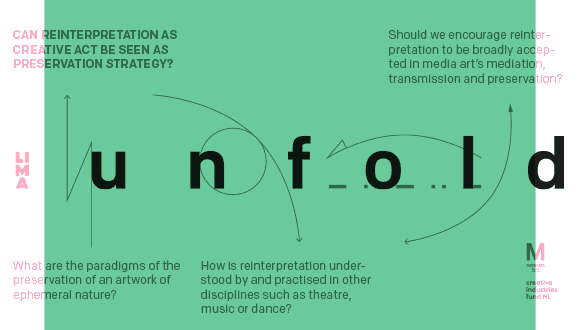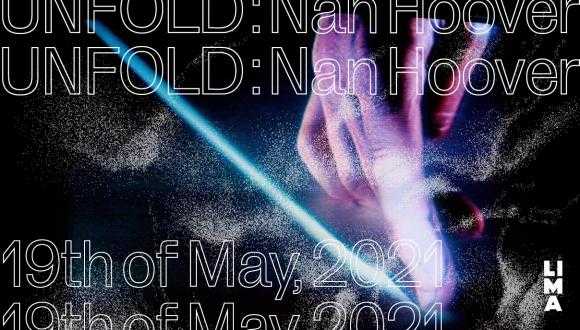UNFOLD Session #1
Mediation by reinterpretation.
Within the context of the UNFOLD research project, LI-MA organised the public event UNFOLD #1 Mediation by Reinterpretation and an expert meeting on 6 June 2016. The first expert meeting and first public event sought to answer the following questions: Can reinterpretation as a creative act be seen as a preservation strategy? Can we integrate other methodologies of preservation like those of theatre, music and dance in the preservation of media art and performance? What are the paradigms of the preservation of artworks of an ephemeral nature?
Participants
Vera Sofia Mota (artist), Fransien van der Putt (radio artist and researcher), Suzanne Tuncha (choreographer), Britte Sloothaak (curator), Serena Cangiano (curator and researcher), Gabriella Giannachi (professor of performance and new media), Elisabeth Schimana (composer, performer and radio artist), Sander van Maas (musicologist), Gaby Wijers (director of LI-MA), Lara Garcia Diaz (art the- orist and researcher), Kristin Scheving (visual artist, curator and project manager), Joost Rekveld (artist), Maura Favero (art historian), Vivian van Saaze (co-ordinator of the Maastricht Centre for Arts, Conservation and Heritage), Claudia Roeck (conservator), Katja Kwastek (professor of art history) and Manuel Pelmus (artist).
Meeting Summary
The first network meeting and first public event took place in June 2016 in Amsterdam. As a starting point, and during these first encounters, we directed our attention to disciplines with a long and rich tradition in mediating work by reinterpretation as music, theatre, and dance, which have ensured their transmission and preservation through live performance. By thinking about how to integrate other methodologies of preservation in the conservation of media art and performance, a subgroup of questions was configured during the meeting.
Subquestions Group 1
How do we mediate to future generations what we do now? Which role should the artist play on the willingness to understand the liveness of his/her/their piece of art? When deepening into the experience of a specific piece rather than a final object to exhibit, which specific script, code or text would be needed to translate media or digital art? Which are the parameters for a specific piece? How to concentrate in the abstraction of an experience?
Thanks to the configuration of this new group of questions, discourses on liveness and performativity in the field of performance, theatre and music studies were incorporated. Here, key elements such as presence, agency, embodiment, and the importance of the event and the audience in relation to media art were integrated next to the exposition of a theoretical background drawn from Jacques Derrida’s Archive Fever (1995). That is, the group of subquestions permitted us to address the human body itself as an archive, trying to “enunciate a past that reaches us through what has been forgotten".
Relevant to this first encounter was also the incorporation of discourses coming from the field of performance studies. For example, Diana Taylor suggests that one of the main aims of performance and performance studies is precisely to seriously consider “the repertoire of embodied practices as an important system of knowing and transmitting knowledge.” Here Taylor proposes that, through embodiment, and therefore through the use of the body as a form of archive, we enable performance to "remain". Thanks to the active participation in the meetings of artist Manuel Pelmus and his idea of "embodied history", choreographer Suzan Tuncha and her presentation around the "intuitive body", or the research around Nan Hoover’s archive by Vera Sofia Mota and Fransien van der Putt among other members in the network meetings, we were able to question the possibility of reinterpretation of artworks through the use of the body: an "embodied history" that produces different readings of the past, present and future with and through the audience. Especially inspiring here was also the two-year research project Inside Movement Knowledge (IMK), an interdisciplinary research project into new methods for the documentation, transmission and preservation of contemporary choreographic and dance knowledge. The overall aim of the IMK was to contribute to dance’s artistic and professional development and enhance the potential of its social benefits by making it more accessible for specialist and general audiences.
All the arguments exposed were brought into dialogue with another key figure in performance studies, Peggy Phelan. Phelan argues that “the process of selection, memorisation or internalisation, and transmission takes place within (and in turn helps constitute) specific systems of representation.” In other words, for Phelan, performance is so closely linked to the dimension of "present" and "presence" that any attempt to preserve it, record it or reproduce it is in itself flawed or deficient. We could argue that what Phelan is proposing is that every act of reproduction would directly be an act of reinterpretation, as it is impossible to repeat exactly what has already happened. In contrast to Phelan, we explore reinterpretation through re-enactment or reperformance as a preservation strategy.
It is important to highlight how this first group of questions expanded the terrain in which we were framing reinterpretation in the first place. That is, the attention was now directed to question the existence of an original and individual piece living in isolation, and the impossibility of its exact repeatability.
Moreover, and from a musicological perspective, composer, performer and radio artist Elisabeth Schimana focuses in the ephemeral quality of music. For Schimana, score is a tool of communication and, in this case, music has always followed an oral tradition for its mediation and transmission. it is important to say that such a transmission has always been done by practice – that is, by doing it through the culture of doing: what keeps a score alive is the community that brings it alive. Departing from that point, Schimana proposes the moment of recreation as a creative act, as, in her opinion, any time one performs a piece is a recreation.
Overall, and always revolving around the very first concern of this first group of questions (Can reinterpretation as creative act be seen as preservation strategy?), the network concluded this first block by arguing that, although the answer will differ from case to case, it is difficult not to identify reinterpretation as a creative act without considering it in relation to another work. That is, although a reinterpretation can constitute a new act, reinterpretation will always exist in a network that connects it with another work. Interestingly, reinterpretation has as its base the word interpret, which is from the Latin word interpretari, which means "explain" or "understand". We hence allow ourselves to understand reinterpretation as the process from which one tries to understand another creative process and how this process emerged in the first place. Having arrived at this point, we agreed that reinterpretation doesn’t aim at reproducing a work from the past in the present but rather works towards the creation of a new work that will coexist in relation to other works.








